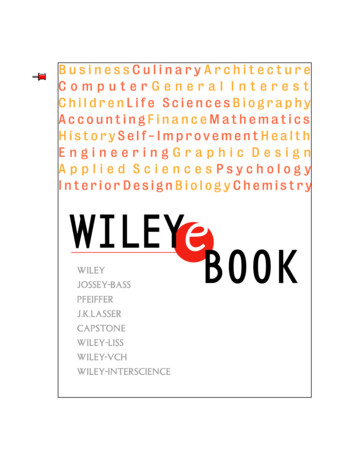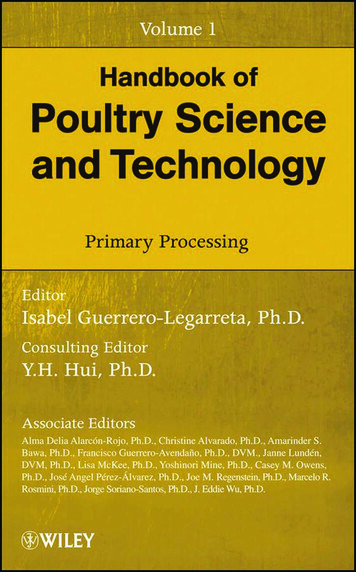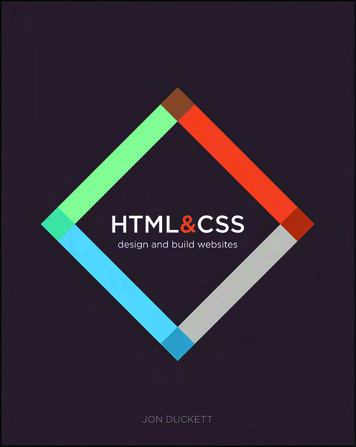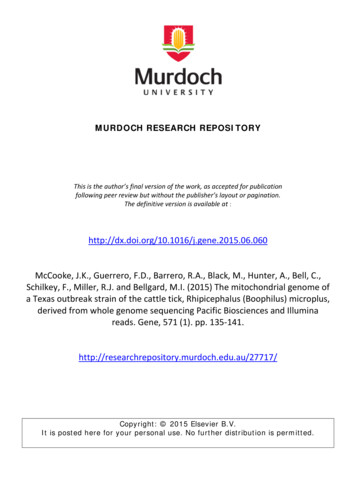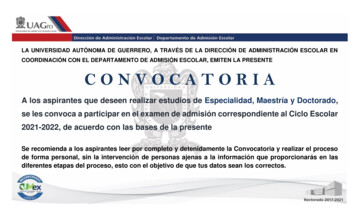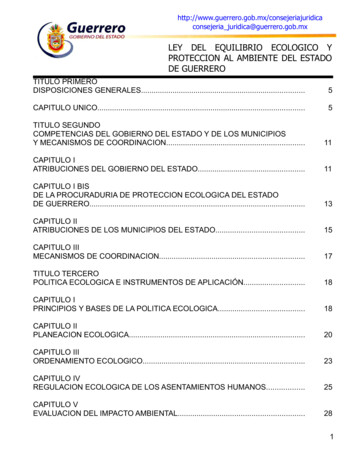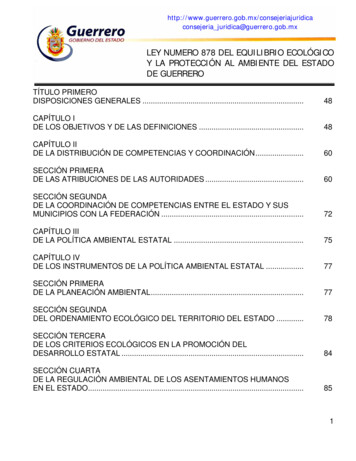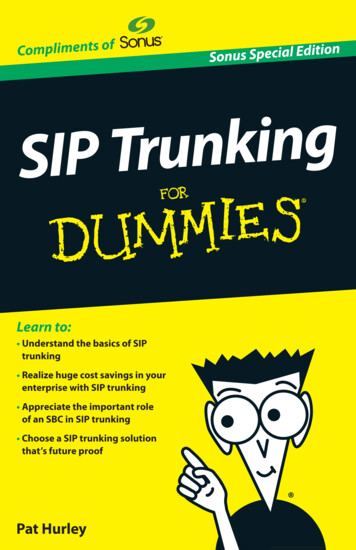
Transcription
Guerrero, T. A., & Wiley, J. (2019). Using “Idealized Peers” for Automated Evaluation of StudentUnderstanding in an Introductory Psychology Course. In Proceedings of the 20th InternationalConference on Artificial Intelligence in Education (pp. 133‐143). Springer, ‐7 12
Using “idealized peers” for automated evaluation ofstudent understanding in an introductory psychologycourseTricia A. Guerrero and Jennifer WileyUniversity of Illinois at Chicago, Chicago IL 60647, USAtguerr9@uic.edu, jwiley@uic.eduAbstract. Teachers may wish to use open-ended learning activities and tests,but they are burdensome to assess compared to forced-choice instruments. Atthe same time, forced-choice assessments suffer from issues of guessing (whenused as tests) and may not encourage valuable behaviors of construction andgeneration of understanding (when used as learning activities). Previous workdemonstrates that automated scoring of constructed responses such as summaries and essays using latent semantic analysis (LSA) can successfully predicthuman scoring. The goal for this study was to test whether LSA can be used togenerate predictive indices when students are learning from social science textsthat describe theories and provide evidence for them. The corpus consisted ofwritten responses generated while reading textbook excerpts about a psychological theory. Automated scoring indices based in response length, lexical diversity of the response, the LSA match of the response to the original text, and LSAmatch to an idealized peer were all predictive of human scoring. In addition,student understanding (as measured by a posttest) was predicted uniquely by theLSA match to an idealized peer.Keywords: Automated assessment, Natural language processing, Latent semantic analysis, Write aloud methodology1Introduction1.1Generative ActivitiesTeachers may wish to use open-ended learning activities and tests, but they are burdensome to assess compared to forced-choice instruments. At the same time, forcedchoice assessments suffer from issues of guessing (when used as tests) and may notencourage valuable behaviors of construction and generation of understanding (whenused as learning activities). The use of generative learning activities such as prompting students to write explanations has been shown to be beneficial to improving understanding when learning in science [1,2,3,4]. Generating explanations can promptstudents to engage in the construction of a mental model of the concepts in the text.The process of writing explanations may be effective because it prompts students to
2generate inferences and make connections across the text and to their own priorknowledge.Prior work has shown that engaging in constructive learning activities, such asgenerating explanations, increases student understanding compared to other morepassive activities such as re-reading [3]. However, other work suggests that the quality of the explanations that are generated may matter [2,5]. This means that studentsmay need feedback on the quality of their explanations in order to gain the benefits ofengaging in this learning activity. In turn, this then places a large burden on teachers.However, if evaluation of student responses such as explanations could be accomplished using automated natural language processing indices, then teachers couldutilize open-ended learning activities with increased frequency. And, the same methods could also be used to score open-ended test questions.1.2Using latent semantic analysis in automated evaluation of responsesLatent semantic analysis (LSA) has been useful in automated evaluation of constructed student responses as it can be used to generate an index representing the overlap insemantic space between two texts [6]. Foltz et al. [7] used multiple approaches withLSA to assess short-answer essays written about a cognitive science topic: how aparticular connectionist model accounts for a psycholinguistic phenomenon (the wordsuperiority effect). Measures of semantic overlap were obtained by comparing studentessays to the original text in two ways: one using the whole text and one using selected portions that were deemed most important. Both approaches were found to behighly correlated with scores obtained from human graders who coded for content andquality of writing. Similarly, Wolfe et al. [8] derived LSA scores by comparing shortstudent essays about heart functioning to a standard textbook chapter, and found theseLSA scores predicted the grades assigned by professional graders (using a 5-pointholistic measure of quality) as well as the scores that students received on a shortanswer test of their knowledge of the topic.In addition to comparing student responses to the original text or a standard text,another approach has compared student responses to an expert summary. León et al.[9] had students read either a narrative excerpt from a novel (The Carob Tree Legend)or an encyclopedia entry (The Strangler Tree) and write a short summary. The LSAcomparison to the “gold standard” expert response was more predictive of humanscoring than the LSA comparison to the original text. Similar results have been obtained in studies with students writing about ancient civilizations, energy sources andthe circulatory system [10], and in response to conceptual physics problems [11].Prior research has used LSA to make comparisons between student responses andexpert responses; however, when experts write responses they tend to use more academic language and make different connections and elaborations than students basedon their prior knowledge [12]. Thus, researchers have also explored making comparisons to peer responses. Both Foltz et al. [7] and León et al. [9] used exact responseswritten by peers to compute an average LSA score from comparisons of each studentresponse with all other student responses. These average scores were predictive ofhuman scoring. Other studies have used LSA to contrast student responses against
3“best peer” responses. Ventura et al. [12] had students write responses to conceptualphysics problems within an intelligent tutoring system. Student responses were compared to both an expert response and a best peer response. The best peer response wastaken randomly from all responses given the grade of an A. When comparing the LSAmatch to the expert response and the best peer response, the LSA match to the bestpeer more accurately predicted the letter grade assigned by a human grader.Other work has used LSA measures based in “idealized” peer comparisons to predict not just human coding, but also student understanding. In Wiley et al. [13], students read texts as part of a multiple document unit on global warming, and wereasked to generate an explanation about how global warming occurs. An idealized peerresponse was constructed to include the key features from the best student essays. TheLSA scores obtained by comparing the student responses to the idealized peer response were predictive of both holistic human scoring, as well as student understanding as measured by an inference verification test given at the end of the unit.The main goal for the present research was to further explore the effectiveness ofautomated scoring using peer-based LSA measures to predict understanding from asocial science text in which a theory was presented along with supporting empiricalresearch and examples to explain the theory. This text structure is representative ofthe style of many social science textbooks, including those in introductory psychology. With such texts, it is the responsibility of the reader to understand how and whythe cited studies and examples support the theory as described. The present studytested whether the LSA match between student comments generated while readingand an experimenter-constructed idealized peer could serve not only as a predictor ofholistic human coding, but also serve as a measure of student understanding.2Corpus and Human Scoring of Responses2.1CorpusThe corpus consisted of short written responses generated by 297 undergraduateswhile reading a text about cognitive dissonance, a key topic that is generally coveredin most courses in introductory psychology. The comments were written by undergraduate students in an introductory psychology course (188 females; Age: M 18.93, SD 1.16) as a part of a homework assignment administered through the Qualtrics survey platform. All responses were edited to correct any typographical errors aswell as to expand contractions and abbreviations. The textbook excerpt that was assigned for this topic had a Flesch-Kincaid reading level of 12.5 and contained 863words in 5 paragraphs. The excerpt began with a real-world example followed by adescription of the theoretical concept. The passage then described two research studies which provided empirical support for cognitive dissonance theory. Students weregiven an initial opportunity to read this textbook excerpt in an earlier homework assignment. During the target activity for this study, students were given a brief instructional lesson on how to generate explanations to support their learning from text:
4As you read the texts again today, you should try to explain to yourself themeaning and relevance of each sentence and paragraph to the overall purpose ofthe text. At the end of each sentence and paragraph, ask yourself questions like: What does this mean? What new information does this add? How does this information relate to the title? How does this information relate to previous sentences or paragraphs? Does this information provide important insights into the major themeof the text? Does this sentence or paragraph raise new questions in your mind?Students then saw an example text with associated example responses to thesequestions that could be written at various points in the text.After the lesson, students reread the textbook excerpt on cognitive dissonance. Atthe end of each of the 5 paragraphs, they were prompted to “write your thoughts” forthe current section of the text similar to a “type-aloud” or “write-aloud” procedure[14]. In addition, they were asked to write their thoughts at the end of the entire text.They were reminded to think about the questions given in the instructions which werepresent in a bulleted list on the screen as a reference while they wrote their thoughts.The 6 thought statements were concatenated into a single response for each studentwith an average length of 190 words (SD 114, range: 6 - 728) and an average lexicaldiversity of 58.05 (SD 34.71, range: .01 - 125.50).Several additional measures were available for each student. Student understandingof the topic following the homework activity was measured by performance on a 5question multiple-choice comprehension test (M 2.44, SD 1.21). As seen in Table1, these questions were designed to test the ability to reason from information in thetext, and to construct inferences about information left implicit in the text, not justverbatim memory for facts and details. Students did not have access to the text whilecompleting the test. This was collected during the next week’s homework activitywhich served as a practice test for the upcoming exam. The data set also includedmeasures of reading ability (ACT scores, M 23.72, SD 3.62) and prior knowledge(performance on a 5-item multiple choice pretest on the topic given during the firstweek of the course, M 1.87, SD 1.14). Prior studies [except 13] have generally notincluded reading ability as a predictor when using automated evaluation systems. Thisleaves open the question of whether automated evaluation systems are solely useful inpredicting general reading ability (and detecting features of essays written by betterreaders) rather than predicting the quality of features in specific responses.2.2Human Scoring of ResponsesStudent responses were scored by two human coders using a rubric adapted fromMcNamara et al. [15] and Hinze et al. [2], similar to what a teacher might use toquickly assess their quality. A score of 0 was assigned to responses that representedlittle to no effort: consisting of only non-word gibberish (“dfkashj”), two or fewerwords per paragraph, or only verbatim phrases that were copied and pasted from the
5original text. Responses that included paraphrased ideas from the text (but no additional elaborations) were assigned a 1 (e.g., “Possible ways to reduce cognitive dissonance include changing one’s behavior,” “Two scientist managed an experiment cognitive dissonance with children and their toys”). Responses that showed evidence ofconstructive processing, such as when students identified connections not explicit inthe text, were assigned a score of 2. This could occur through identifying the relationsbetween theories and evidence, or making connections to relevant prior knowledge(e.g., “Whenever people have conflicting beliefs and actions, some sort of resolutionmust occur. The conflict causes psychological distress and must be removed. In orderto reduce cognitive dissonance, they must alter their beliefs to match the action oraltering behaviors to match the belief”). Interrater agreement between two codersresulted in Cohen’s kappa of .92.Table 1. Paragraph 3 of cognitive dissonance text, idealized-peer response from concepts appearing in highest scoring student responses, and example test question.Text ExcerptIn 1959, Festinger and Carlsmith conducted an experiment which tested cognitive dissonancetheory. Participants were asked to spend an hour performing a very boring task . These participants were asked to recommend the experiment they had just completed to other potentialparticipants who were waiting to complete the experiment. They were instructed to tell thesepotential participants that the experiment was fun and enjoyable. Half of the participants in thisgroup were paid 1 to recommend the experiment and the other half were paid 20. Theseparticipants were then taken to the interview room and asked the same questions as the participants in the control group, who were not paid and were not asked to talk to other participants.The participants in the 20 group responded similarly to the participants in the control group,namely that they did not find the experiment to be enjoyable and that they would not sign up toparticipate in a similar experiment. In contrast, participants in the 1 group rated the experiment as more enjoyable than participants in the other two groups, and indicated that they wouldbe more willing to participate in another similar experiment.Most frequent concepts inIdealized-peer responsebest responses-Identify groups performing simi- The control group and the 20 group both told the truth thatlarly (18%)they did not enjoy the experiment. The 1 group rated the-Question the reasoning for reexperiment as more enjoyable. This does not make sense.sults of study (72%)Why would the 1 group say it was fun?Test QuestionImagine that the theory in the text was incorrect and that people do not experience cognitivedissonance. Which result of the Festinger experiment (about getting paid to do a boring task)would you expect?a. The control group who got paid nothing would have said they found the task very interesting.b. The group paid 1 would have said they found the task to be boring.c. The group paid 20 would have said they found the task to be very interesting.d. How much people got paid would not have had a bigger effect on what they said aboutthe task.
62.3Idealized-peer responseThe idealized-peer response was constructed by selecting concepts and phrases thatappeared most frequently in responses to each of the 5 paragraphs across the beststudent comments (i.e., scored as “2” by human raters). An example of the idealizedpeer response for one paragraph is shown in Table 1. The idealized response, writtenat the 8th grade level, included a paraphrase of the main point and 1-2 of the mostfrequent elaborations for each paragraph. The elaborations were often written in thefirst and second person. Elaborations also included explicit connections between thetheories presented and the experiments that were left implicit in the original text, andmetacognitive comments (e.g., I am not sure why they would do that?).3Results using Automated Scoring Indices3.1Automated scoring indicesFour automated measures were computed. Two measures were calculated using LSA.The first compared the student response to the actual text excerpt that was read(LSAORIG). The second compared the student response to the idealized-peer response (LSAIDEAL). In addition, the total response comment length (LENGTH) wascomputed using Linguistic Inquiry and Word Count (LIWC) [16] and the lexical diversity (LEXDIV) of all words in each student response was measured using CohMetrix index LDVOCDa [17]. The length of a response is often predictive of humanscoring, accounting for over 35% of the variance in human-scored responses [18-20].The variety of words used can also predict human scoring. In essays where studentswere asked to describe the popularity of comic books or wearing name-brand fashions, or to write letters responding to a complaint or welcoming an exchange student,the lexical diversity of the response was a positive predictor of essay grades assignedby human raters [20]. While features such as the number and diversity of words within a student response may influence human scoring, other work has found that lengthmay not predict student understanding, and the relation between lexical diversity andunderstanding may became negative once the LSA match with the idealized peeressay is taken into account [13]. To further explore these relations, two additionalautomated measures (LENGTH, LEXDIV) were included in the present analyses.Table 2. Correlations among measures for student ****Correlations are significant at the 0.01 level.
7As shown in Table 2, human scoring (HUMAN) predicted posttest performance(POSTTEST). LSA measures predicted human scoring, and were at least as strong ofpredictors of posttest performance as human scoring. Descriptively, the strongestsingle predictor of posttest performance was the match with LSAIDEAL (althoughthis correlation was not significantly stronger than the correlation with HUMAN scoring, z 1.01, p .16). Despite the significant correlations among measures, varianceinflation factors in all reported analyses remained below 1.8 indicating that multicollinearity was not an issue for analyzing the measures together in regressions.3.2Relation of automated scoring to human scoringAs shown in Table 2, the simple correlations between human scores and all four automated measures were significant. However, as shown in Table 3, when they wereall entered simultaneously into a regression model, LSAORIG was no longer a significant predictor of human scoring. LSAIDEAL and LEXDIV both remained as positive unique predictors of the human scores, with the full model accounting for 58% ofthe variance in human scores, F(4,292) 130.53, p .001.Table 3. Human-scored quality as predicted by automated measures.VariableUnstandardizedBeta (B)Std. Beta (β)t-valuep-value3.17.0020.814.42.163.56 .001-.01-0.15.8810.72 .001.04Relation of automated scoring to student understandingAs shown in Table 2, the simple correlations between student understanding (assessedby posttest scores) and automated measures were only significant for the two LSAmeasures (LSAORIG and LSAIDEAL). Posttest scores were not significantly predicted by response length (LENGTH) or lexical diversity (LEXDIV). Further, asshown in Table 4, only LSAIDEAL remained as a significant predictor, R2 .04F(4,292) 4.13, p .003, when all 4 automated measures were entered simultaneously.
8Table 4. Student understanding as predicted by automated DEAL3.4UnstandardizedBeta (B)1.230.000.000.132.16Std. Error0.310.000.000.820.93StandardizedBeta 33 .001.99.43.88.02Unique contribution of LSAIDEAL over and above reader characteristicsIt is typically the case that students who are better readers or who have priorknowledge of a topic will develop better understanding when learning from text. Indeed, both ACT scores (r .25) and prior knowledge measures (PRETEST, r . 29)were significant predictors of posttest scores. However, as shown in Table 5,LSAIDEAL remained as a significant predictor even when both ACT scores and priorknowledge were included in the model, R2 .17, F(3,249) 16.79, p .001.Table 5. Student understanding as predicted by LSAIDEAL and reader AL3.5UnstandardizedBeta (B)-0.800.070.221.97Std. Error0.540.020.060.49StandardizedBeta (β).22.21.23t-valuep-value-1.493.773.634.01.14 .001 .001 .001Comparison of LSAIDEAL to other LSA alternativesThere are several possible reasons why idealized peer responses were more predictiveof understanding than the original text. One may be that sections in introductory textbooks contain a large number of ideas about each topic. The idealized peer responsemay gain its power by selecting out the most relevant ideas from the section. Thus,when a student’s response overlaps heavily with the content of the idealized peerresponse, this may reflect that student’s ability to identify, select, and attend to themost relevant features of the text. This may be similar to the predictive value of justthe most important sentences within the text [7]. A second possible reason may bebecause idealized peer comments are written in more colloquial language that otherstudents may be more likely to use [12,13]. A third possible reason is that idealizedpeer responses may explicitly mention key inferences and connections that are leftimplicit in the text [12]. And finally, constructing an idealized peer response frommultiple high-quality student responses may be better than using only one randomlyselected “best student” because comments vary and contain many idiosyncrasies thatmay be relevant based on the prior knowledge of one individual more so than another.
9To better understand what may be responsible for the predictive power of the idealized peer response, several alternative LSA comparisons were computed: the match ofeach student’s comments to the same concepts in the LSAIDEAL but written in academic language at a 12th grade level (ACADEMIC), to an automated selection (selected by R package LSAfun [22]) of the important sentences in each section of thetext (LSAFUN), to important sentences as selected by expert (SELECTED), to sentences written by an expert to represent the explicit connections that need to be madeto comprehend the text (EXPLICIT), and to a randomly chosen single best peer response (BESTPEER). The partial correlations after controlling for the unique contributions to prediction from reading ability and prior knowledge are shown in Table 6.Table 6. Partial correlations among LSA measures and student .23**.23****Partial correlations are significant at the 0.01 level.Note. Controlling for reading ability (ACT) and prior knowledge (pretest).4DiscussionThis study tested multiple automated measures that may be useful for assessing student understanding. Students wrote responses while reading a textbook excerpt oncognitive dissonance, a commonly taught subject in introductory psychology courses.All responses were scored for quality by both humans and using automated measures.Although lexical diversity of the comments was a significant positive predictor ofhuman scoring, it was not predictive of student understanding as measured by theposttest. When the intended purpose of a learning activity is to promote student understanding, and when the goal for using automated measures is to predict studentunderstanding (rather than to match holistic impressions of human scorers), then features such as length and lexical diversity may be less useful.In contrast, the LSA match with the idealized-peer response provided a better fitfor both human scoring and for student understanding than did the LSA match to theoriginal text. Although this predictive model accounted for a relatively small proportion of the variance in test scores, it provides a first step in exploring how learningactivities that prompt students to record their thoughts online as they are attempting tocomprehend a text might be able to utilize automated evaluation techniques.This study represents an advance beyond prior work by the inclusion of readingability and prior knowledge in the prediction models, as well as by testing across a
10wide range of LSA metrics. Similar results were seen between idealized responseswritten in academic and more colloquial language indicating that the use of peer language may not be as important as hypothesized. Further, the use of idealized peerresponses that included multiple elements from several of the best students seemed toproduce a better standard than a single randomly chosen best response (although thisfinding may be highly variable based on the single response chosen). Additionally, anexpert may choose slightly better sentences than an automated system (LSAfun), butthe advantage of automation may be important for broader implementation.Another limitation of the current implementation was that the student responsesneeded to be edited to correct misspellings and abbreviations prior to processing toachieve these results. However, simply requiring students to use a spelling and grammar check tool prior to submission has been successful in properly editing responsesfor processing [10]. Adding that feature could also aid automation in this case.5Conclusion and Future DirectionsThe main goal for the present research was to further explore the effectiveness ofautomated scoring using LSA to predict understanding from a social science text inwhich a theory was presented along with supporting empirical research and examplesto explain the theory. The results of the present study demonstrated that the LSAmatch between student comments and an idealized peer could serve not only as apredictor of holistic human coding, but also as a measure of student understanding.Ultimately, the motivation behind developing and testing for effective means of automated coding of student responses is to enable the development of automated evaluation and feedback systems that support better student comprehension when attempting to learn from complex social science texts. Generative activities can be beneficialfor learning, but they may be especially effective when feedback is provided to students. Moving forward, the next step in this research program is exploring how thisautomated scoring approach can be used to provide intelligent feedback to students asthey engage in these learning activities.Though the predictive power of this approach is limited, the results of the presentstudy are promising as they suggest that evaluations of response quality derived froman LSA index based in the match between students’ comments and an idealized-peermight be just as helpful as having a teacher quickly assess the quality of studentcomments made during reading. Utilizing these automated measures may make itmore feasible for teachers to assign learning activities that contain open-ended responses, and for students to learn effectively from them.Acknowledgements. This research was supported by grants from the Institute forEducation Sciences (R305A160008) and the National Science Foundations (GRFP tofirst author). The authors thank Grace Li for her support in scoring the student responses, and Thomas D. Griffin and Marta K. Mielicki for their contributions as partof the larger project from which these data were derived.
11References1. Chi, M. T. H.: Self-explaining expository texts: The dual process of generating inferencesand repairing mental models. In: Glaser, R (ed.) Advances in instructional psychology, pp.161-237. Erlbaum: Mahwah, NJ (2000).2. Hinze, S. R., Wiley, J., Pellegrino, J. W.: The importance of constructive comprehensionprocesses in learning from tests. Journal of Memory and Language, 69, 151-164. (2013).3. Chi, M. T. H., de Leeuw, N., Chiu, M. H., LaVancher, C.: Eliciting self-explanation improves understanding. Cognitive Science, 18, 439-477 (1994).4. McNamara, D. S.: SERT: Self-explanation reading training. Discourse Processes, 38, 1-30(2004).5. Guerrero, T. A., Wiley, J.: Effects of text availability and reasoning processes on test performance. In: Proceedings of the 40th Annual Conference of the Cognitive Science Society, pp. 1745-1750. Cognitive Science Society, Madison, WI (2018).6. Landauer, T. K., Foltz, P. W., Laham, D.: An introduction to latent semantic analysis. Discourse processes, 25, 259-284 (1998).7. Foltz, P. W., Gilliam, S., Kendall, S.: Supporting content-based feedback in on-line writingevaluation with LSA. Interactive Learning Environments, 8, 111-127 (2000).8. Wolfe, M. B., Schreiner, M. E., Rehder, B., Laham, D., Foltz, P. W., Kintsch, W., Landauer, T. K.: Learning from text: Matching readers and text by latent semantic analysis. Discourse Processes, 25, 309-336 (1998).9. León, J. A., Olmos, R., Escudero, I., Cañas, J. J., Salmerón, L.: Assessing short summarieswith human judgments procedure and latent semantic analysis in narrative and expositorytexts. Behavior Research Methods, 38, 616-627 (2006).10. Kintsch, E., Steinhart, D., Stahl, G., LSA Research Group: Developing summarizationskills through the use of LSA-based feedback. Interact
student understanding in an introductory psychology course Tricia A. Guerrero and Jennifer Wiley University of Illinois at Chicago, Chicago IL 60647, USA tguerr9@uic.edu, jwiley@uic.edu Abstract. Teachers may wish to use open-ended learning activities and tests, but they are burdensome to assess compared to forced-choice instruments. At
